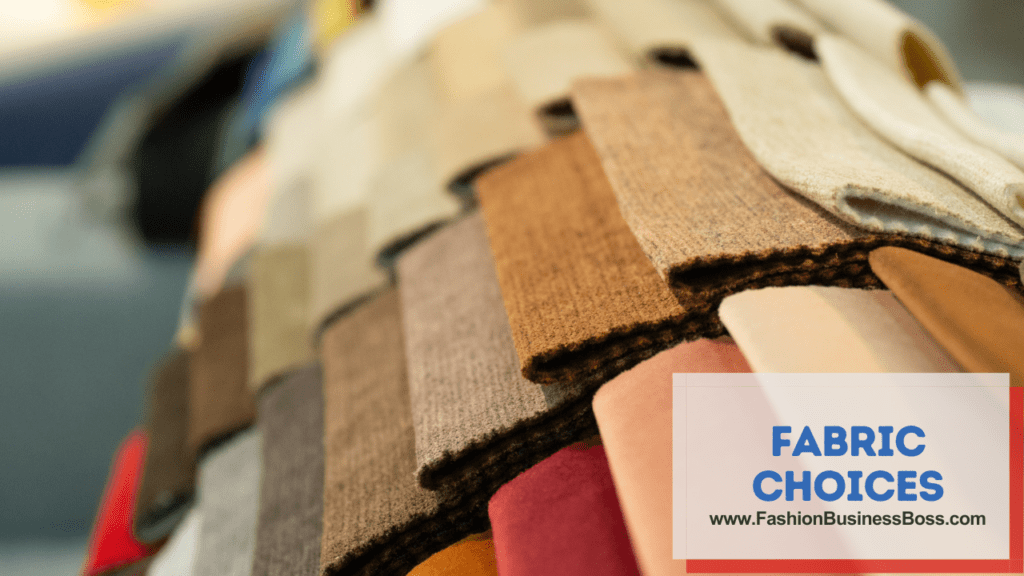The world of fashion is not only about wearing stylish outfits; it’s also about creating them. Designing and manufacturing your own clothing line is a good venture to start from.
Here are some essential steps for creating your clothing design: start with a simple item, gather tools, create a pattern, choose fabric, cut, sew, fit, add finishing touches, and remember to practice and be patient.
In this article, we are here to help you know how to create your own clothes from scratch.
Selecting Your Design

When you embark on the journey of manufacturing your own clothing, it’s important to begin with a well-thought-out plan. Your initial step is selecting a design for your garment. It’s advisable to opt for a straightforward and uncomplicated clothing item for your first project. A basic T-shirt or a simple skirt are excellent choices.
Selecting a simple design is key for several reasons. Firstly, it allows you to focus on mastering the foundational skills required for clothing production. A basic design typically involves fewer intricate details and seams, making it more manageable for beginners. This choice helps you develop your sewing skills gradually.
Moreover, starting with a simple clothing item helps you gain confidence in the manufacturing process. You’ll feel a sense of accomplishment as you complete your first project, and this will motivate you to take on more complex designs in the future. So, take your time in selecting a basic design that suits your style and skill level, as it’s the initial step towards creating your own clothing.
Read more about: Dress to Impress: Top Websites for Making Your Own Clothes
Gather Essential Tools
As you begin your journey into clothing manufacturing, the first step is to gather the essential tools. These tools serve as the foundation for your clothing production endeavors. The most crucial item on your list is a sewing machine, as it will be the primary tool for stitching your garments.
You’ll also need a variety of needles suitable for different fabric types to ensure smooth sewing. Threads in various colors are essential for stitching, so make sure to have a selection on hand. Fabric scissors, specifically designed for clean fabric cutting, are a must to prevent fraying. Pins play a significant role in holding your fabric pieces together during sewing, ensuring they stay aligned and secure. Lastly, a measuring tape is indispensable for accurate measurements, which are vital in the garment-making process.
These tools collectively enable you to work efficiently and create well-crafted clothing items. Just as a chef relies on a well-equipped kitchen, having the right tools at your disposal is key to a clothing manufacturing project.
Pattern Creation
Creating a pattern is a fundamental step in clothing manufacturing. It’s like crafting the blueprint for your garment. There are two main approaches to consider: you can either draft the pattern yourself, taking precise measurements of the person who will wear the clothing, or you can search online for free patterns that align with your chosen design.
If you opt to create your own pattern, start by carefully measuring the individual who will wear the clothing. Accurate measurements are crucial to ensure a proper fit. You’ll need measurements for key areas such as chest, waist, hips, and more, depending on the garment type. With these measurements in hand, you can then draft a pattern on paper, making sure it aligns with your design vision.
Alternatively, finding free patterns online can be a time-saving and accessible choice, especially for beginners. Numerous websites offer patterns for various clothing items. By selecting a pattern that matches your design, you can streamline the pattern creation process and focus on bringing your clothing to life. Regardless of the approach you choose, investing time in pattern creation is a vital step in the clothing manufacturing journey.
Fabric Choices

Choosing the right fabric is a critical aspect of clothing manufacturing, as it greatly influences the outcome of your project. When making this selection, you should focus on finding a fabric that aligns with your design and pattern.
Start by considering the color of the fabric. It should match or harmonize with the color scheme of your design. This ensures that your clothing item appears cohesive and visually appealing.
Texture is another factor to keep in mind. Think about the tactile qualities of the fabric. Is it smooth, rough, soft, or coarse? The texture of the fabric should correspond to the intended look and feel of your garment.
Consider the stretch of the fabric. Does it have any elasticity, or is it rigid? The stretchiness of the fabric should align with the comfort and fit requirements of your design.
The fabric you choose should complement your chosen pattern. It’s like selecting the right canvas for a painting; the fabric serves as the canvas for your clothing creation. So, take your time to weigh these factors, ensuring that your fabric choice harmonizes with your design and pattern, ultimately contributing to the quality and aesthetics of the final garment.
Read more about: Dress with Confidence: Mastering Your Unique Style
Cutting the Fabric
The step of cutting the fabric is a pivotal point in the clothing manufacturing process. It’s like shaping the pieces of a puzzle to create the final picture. To carry out this step effectively, you need to prepare a flat and clean surface where you can lay out your chosen fabric.
Once the fabric is neatly spread out, it’s time to cut it following the pattern you’ve created. This step demands precision and careful attention. Use fabric scissors designed for this purpose, as regular scissors may result in frayed edges. Make sure to adhere closely to the pattern lines you’ve drawn, as any deviations can affect how the pieces fit together.
The accurate cutting of the fabric is crucial to ensure that your clothing piece assembles correctly. Think of it as the foundation of your garment. If the pieces aren’t cut precisely, it’s similar to having mismatched puzzle pieces that won’t come together to create the intended picture. So, by taking your time and cutting with care, you set the stage for the seamless construction of your clothing item, ensuring it fits and looks as planned.
Sewing Techniques
Mastering fundamental sewing techniques is akin to laying a strong foundation for your clothing manufacturing journey. These techniques are like the basic alphabet of sewing, essential to create well-constructed garments.
Start by learning straight stitching. It’s the simplest and most commonly used stitch. Straight stitching joins fabric pieces together in a straight line. This stitch is fundamental for sewing seams and hems in your clothing items.
Backstitching is another crucial skill. This technique reinforces the seams, preventing them from unraveling over time. By backstitching at the beginning and end of your seams, you ensure durability and longevity in your garments.
Finishing seams is the final piece of the puzzle. It involves neatly sealing the edges of the fabric to prevent fraying. This step not only adds a professional touch but also enhances the longevity of your clothing items.
These sewing techniques are the building blocks of clothing construction. They are the essential tools that allow you to bring your clothing design and pattern to life. By mastering these basic skills, you’ll be better equipped to create well-crafted garments that are both functional and visually appealing.
Assembling the Garment

The process of assembling your garment is a crucial step in the clothing manufacturing journey. It’s akin to putting together the pieces of a puzzle to form a complete picture. To achieve this, carefully follow the instructions provided in your pattern.
Start by laying out the fabric pieces you’ve cut according to the pattern. Pay close attention to the seam allowances, which are the spaces between the stitching and the fabric’s edge. Ensure that your seams align with the designated seam allowances, as this affects the fit and overall look of your garment.
Sew the fabric pieces together in the order specified by the pattern. The order of assembly is like following a recipe; each step must be completed in a particular sequence for the final result to turn out as intended.
By meticulously following the pattern instructions and keeping an eye on seam allowances, you’ll be able to sew your fabric pieces together in a precise and orderly manner. This process brings your clothing item one step closer to completion, ensuring it fits and looks as envisioned in your design.
Read more about: Dressing for Digital Growth: Selling Clothes Online
Fitting and Adjustments
Throughout the process of assembling your garment, it’s important to keep an eye on the fit. Imagine it as sculpting a piece of clay to create the desired shape. To do this, periodically try on the garment as you put it together.
These fitting checkpoints are crucial because they allow you to assess how the garment is taking shape. By trying it on, you can identify areas where adjustments are needed. If the fit feels tight, loose, or uncomfortable in any way, it’s a signal to make necessary modifications.
Adjustments may include altering seams, hemlines, or other areas to ensure the clothing piece fits comfortably and aligns with your original design vision. Think of it as fine-tuning a musical instrument to produce the right notes.
Regularly checking and adjusting the fit as you go is like a craftsman refining a work of art. It ensures that the garment is not only aesthetically pleasing but also comfortable to wear. This iterative process helps you create a clothing item that matches your vision and is well-suited to its intended purpose.
Finishing Touches
In the final stages of creating your garment, attention to finishing touches is key. These details are like adding the last brushstrokes to a painting, completing the overall look and functionality of your clothing piece. Here’s what you should consider:
Hemming involves folding and sewing the edges of the fabric to create neat and clean finishes at the openings of sleeves, pants, or the bottom of the garment. It prevents fraying and adds a polished appearance.
Depending on your design, you might need buttons, zippers, or other closure methods. These components allow for easy wearing and removal of the garment. Properly attaching them ensures functionality and style.
Some designs may require additional closures like hooks, snaps, or ties. These serve both functional and decorative purposes, ensuring that your clothing piece stays in place and aligns with your design vision.
Practice and Patience

Embarking on the journey of making clothes from scratch can be a challenging endeavor, especially for those new to the craft. It’s similar to learning a musical instrument or a new language; it takes time and dedication. In this process, two important allies are practice and patience.
Just like rehearsing a musical piece or practicing a new language, sewing and clothing manufacturing require repetition and honing of skills. As you practice, you become more adept at using your sewing machine, handling fabrics, and following patterns. Over time, your stitches become neater, and your creations more refined.
Learning a new skill, including clothing manufacturing, often involves making mistakes. These errors are akin to wrong notes in a song or errors in language pronunciation. It’s essential to approach these setbacks with patience. Instead of feeling discouraged, view them as valuable learning experiences. Mistakes provide insights into how to improve and refine your techniques.
By acknowledging that practice and patience are your companions on this journey, you’ll find that the challenges of clothing manufacturing become more manageable. With time and dedication, you’ll build your skills, learn from your mistakes, and progress in creating garments that reflect your vision.
Read more about: Dressing the World: How to Manufacture a Clothing Line?
Conclusion
Starting with simple projects and gradually advancing to more complex designs will help you develop your skills and confidence. Enjoy the creative process and take pride in the fact that you made your own clothing from scratch.
Frequently Asked Questions

Q: How can one choose the appropriate fabric for a clothing project?
A: The selection of fabric depends on the specific garment’s purpose and design. Factors like color, texture, and stretch must be considered to complement the chosen pattern.
Q: What are the fundamental sewing techniques for beginners?
A: Essential sewing techniques for beginners include straight stitching, backstitching, and finishing seams. Proficiency in these skills is crucial for clothing construction.
Q: How is a clothing pattern created?
A: Creating a clothing pattern involves either drafting one manually by taking measurements or locating free patterns online that align with the chosen design.
Q: What are the necessary tools to begin sewing?
A: Essential tools for sewing include a sewing machine, needles, thread, fabric scissors, pins, and a measuring tape. Having the right equipment is essential for a sewing project.
Q: How can adjustments be made for a better fit in a garment?
A: While assembling the garment, regularly assess the fit by trying it on. Make necessary adjustments as you progress to ensure a comfortable fit for the clothing piece.
To learn more about starting your own clothing business, check out my startup documents here.
Please note that the contents of this blog are for informational and entertainment purposes only and should not be construed as legal advice. Any action taken based on the information provided in this blog is solely at your own risk. Additionally, all images used in this blog are generated under the CC0 license of Creative Commons, which means they are free to use for any purpose without attribution.

Meet Shawn Chun: Entrepreneur and Fashion Business Fan.
I’m a happy individual who happens to be an entrepreneur. I have owned several types of businesses in my life from a coffee shop to an import and export business to an online review business plus a few more and now I create online resources for those interested in starting new ventures. It’s demanding work but I love it. I do it for those passionate about their business and their goals. That’s why when I meet a designer or boutique owner at a craft fair, farmers market, retail location or anywhere else I see myself. I know how hard the struggle is to retain clients, find good employees and keep the business growing all while trying to stay competitive.
That’s why I created Fashion Business Boss: I want to help fashion business owners like you build a thriving business that brings you endless joy and supports your ideal lifestyle.

